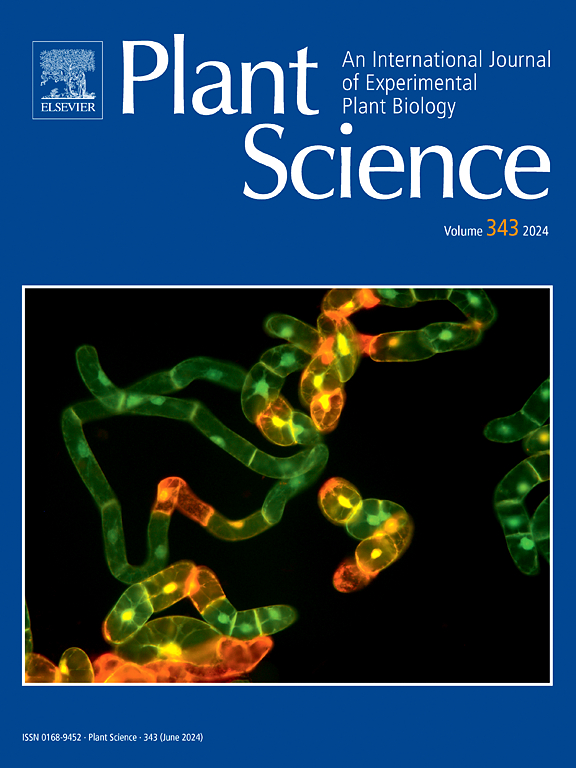综合代谢组学和转录组学分析揭示了荒漠植物单细胞C4光合途径SaPEPC1基因在拟南芥中的光合作用
IF 4.2
2区 生物学
Q2 BIOCHEMISTRY & MOLECULAR BIOLOGY
引用次数: 0
摘要
磷酸烯醇丙酮酸羧化酶(PEPC)在高等植物光合代谢中起着重要作用。虽然涉及PEPC的光合途径已经明确,但不同光强处理对植物光合和PEPC代谢的影响还需要进一步研究。本研究以野生型(WT)拟南芥为对照,研究SaPEPC1过表达对拟南芥光合和代谢的影响。结果表明,强光促进拟南芥生长,弱光抑制拟南芥生长。在不同光强处理下,SaPEPC1过表达导致光合速率(Pn)和光合酶活性(PEPC、Rubisco、PPDK、NADP-ME)增加,细胞间CO2浓度(Ci)降低,蔗糖积累量、叶长、叶宽和茎部鲜重增加。转录组学数据分析显示,转基因拟南芥在强光下淀粉、蔗糖和谷胱甘肽代谢途径显著富集。与此同时,多个与淀粉和蔗糖代谢相关的差异表达基因上调,包括AtBAM5、AtSUS6和AtTPS5;大部分谷胱甘肽代谢相关基因表达下调。转基因拟南芥的代谢组学数据分析得到56种代谢物,其中大多数被发现参与三羧酸(TCA)循环,随后进行糖酵解。在强光下,转基因植株中l -天冬氨酸、富马酸、苹果酸、草酰乙酸、柠檬酸和琥珀酸的含量高于野生型植株。综上所述,SaPEPC1在拟南芥中过表达导致了光合速率的提高,促进了TCA循环,且这些变化在强光处理下更为明显。本文章由计算机程序翻译,如有差异,请以英文原文为准。
Comprehensive analyses of the metabolome and transcriptome reveal the photosynthetic effects in Arabidopsis thaliana of SaPEPC1 gene from desert plant with single-cell C4 photosynthetic pathway
The enzyme phosphoenolpyruvate carboxylase (PEPC) plays an important role in the photosynthetic metabolism of higher plants. Although the photosynthetic pathway involving PEPC has been clarified, further investigation is required to elucidate the effects of different light intensity treatments on plant photosynthetic and metabolism of PEPC. In this study, wild-type (WT) Arabidopsis was used as a control to investigate the effect of SaPEPC1 overexpression on the photosynthesis and metabolism of Arabidopsis. The results showed that intense light promoted and weak light inhibited the growth of Arabidopsis. Under different light intensity treatments, overexpression of SaPEPC1 led to increases in the photosynthetic rate (Pn) and photosynthetic enzyme activity (PEPC, Rubisco, PPDK, NADP-ME), a decrease in the intercellular CO2 concentration (Ci), and increases in sucrose accumulation, leaf length, leaf width, and shoot fresh weight. Transcriptomic data analysis revealed that the starch, sucrose, and glutathione metabolic pathways were significantly enriched in transgenic Arabidopsis under intense light. This was accompanied by the up-regulation of multiple differentially expressed genes related to starch and sucrose metabolism, including AtBAM5, AtSUS6, and AtTPS5; the expression of most genes related to glutathione metabolism was down-regulated. A targeted metabolomic data analysis of transgenic Arabidopsis yielded 56 metabolites, the majority of which were found to participate in the tricarboxylic acid (TCA) cycle, followed by glycolysis. The content of L-aspartate, fumaric acid, malic acid, oxaloacetate, citric acid, and succinic acid was higher in transgenic lines than in WT under intense light. In conclusion, the overexpression of SaPEPC1 in Arabidopsis resulted in an increase in the photosynthetic rate and promoted the TCA cycle, and these changes were more pronounced under intense light treatment.
求助全文
通过发布文献求助,成功后即可免费获取论文全文。
去求助
来源期刊

Plant Science
生物-生化与分子生物学
CiteScore
9.10
自引率
1.90%
发文量
322
审稿时长
33 days
期刊介绍:
Plant Science will publish in the minimum of time, research manuscripts as well as commissioned reviews and commentaries recommended by its referees in all areas of experimental plant biology with emphasis in the broad areas of genomics, proteomics, biochemistry (including enzymology), physiology, cell biology, development, genetics, functional plant breeding, systems biology and the interaction of plants with the environment.
Manuscripts for full consideration should be written concisely and essentially as a final report. The main criterion for publication is that the manuscript must contain original and significant insights that lead to a better understanding of fundamental plant biology. Papers centering on plant cell culture should be of interest to a wide audience and methods employed result in a substantial improvement over existing established techniques and approaches. Methods papers are welcome only when the technique(s) described is novel or provides a major advancement of established protocols.
 求助内容:
求助内容: 应助结果提醒方式:
应助结果提醒方式:


